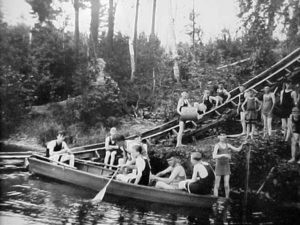Fayal Township is a township located in St. Louis County, Minnesota with a total area of 34.5 square miles. Fayal Township is home to ten lakes, which equal a total area of 8.77% of the township. As of the census of 2000, there are 1,906 people, 769 households, and 586 families residing in the township. The median age is 45 years, and the median household income is $50,665. Fayal Township was named for the most western island in the central group of the Azores and was organized in 1896, following the beginning of important mining operations and explorations. A petition was circulated among residents in the congressional township 57-17 to organize the township under chapter ten of the General Statutes of Minnesota, 1878. The petition was dated February 4, 1896, and was filed with the county auditor. On February 6, 1896 the county commissioners approved the organization of Fayal and passed a resolution granting the petition and ordering an election to be held on February 25, 1896. The election was held, and the township organization was legally brought to completion. The population in 1900 was 1,016. The population per the 2010 census was 1,809 people, 785 households, 585 families & the median age is 51.9 years. Per the 2013-2017 American Community Survey Estimates, median income is $80,455.



Pictures of Fayal Township’s early history hang on the walls of the Fayal Town Hall. Mining was the driving force in the organization of the township when in November 1893, David T. Adams of Duluth, discovered merchantable ore in Fayal. This discovery was in the vicinity of the northwest quarter of the northwest quarter of section 5, and the north half of the northwest quarter of section 6, township 57-17. The Fayal No. 1 was explored by the McInnis Mining Company and organized on the 31st day of January 1894. The area was divided into five mines by different mining interests and was classed among the greatest mines of the Mesabi Range. Eventually the Fayal mines passed to the Oliver Iron Mining Company, which has since controlled them. By the end of 1919 they had yielded an aggregate of 29,908,246 tons, more than a million tons a year since the beginning. At first, the mining was by shaft, but later three different systems were being operated concurrently. There were two large open pits, milling being carried on in one and loading direct into cars with steam shovels in the other, while underground mining was continued.


Even though there was much work to do in those days, there were places to go and have fun. The Scout Camp, now called Camp Chicagami, was host to many good times for area youth.
 For the women, the Oliver Mining Company constructed the Olcott Lodge on the shore of Half Moon Lake. It was here that women could come to rest and relax for a few days. In 1927, seventy women registered to spend time at the Lodge, and in 1928 there were seventy-two. A matron was employed at the Lodge to operate the enterprise and keep harmony amongst the guests. Women would register to spend time at the Lodge and a selection committee would try to process the grouping of women by nationalities, due to limited knowledge of the English language.
For the women, the Oliver Mining Company constructed the Olcott Lodge on the shore of Half Moon Lake. It was here that women could come to rest and relax for a few days. In 1927, seventy women registered to spend time at the Lodge, and in 1928 there were seventy-two. A matron was employed at the Lodge to operate the enterprise and keep harmony amongst the guests. Women would register to spend time at the Lodge and a selection committee would try to process the grouping of women by nationalities, due to limited knowledge of the English language.
 Of course there was always the Ely Lake Beach for all to enjoy! If you have any historic pictures about Fayal Township, please use the form on the contact page to let us know. We would be happy to include them in this website.
Of course there was always the Ely Lake Beach for all to enjoy! If you have any historic pictures about Fayal Township, please use the form on the contact page to let us know. We would be happy to include them in this website.
